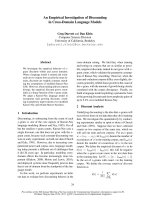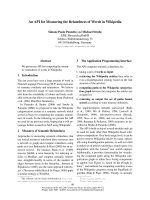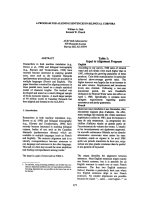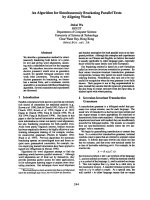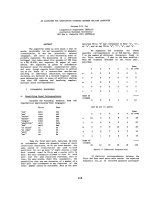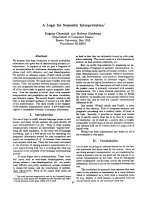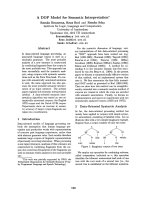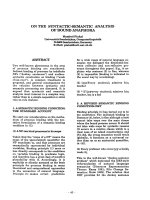Báo cáo khoa học: "An Algebra for Semantic Construction in Constraint-based Grammars" pot
Bạn đang xem bản rút gọn của tài liệu. Xem và tải ngay bản đầy đủ của tài liệu tại đây (88.36 KB, 8 trang )
An Algebra for Semantic Construction in Constraint-based Grammars
Ann Copestake
Computer Laboratory
University of Cambridge
New Museums Site
Pembroke St, Cambridge, UK
Alex Lascarides
Division of Informatics
University of Edinburgh
2 Buccleuch Place
Edinburgh, Scotland, UK
Dan Flickinger
CSLI, Stanford University and
YY Software
Ventura Hall, 220 Panama St
Stanford, CA 94305, USA
Abstract
We develop a framework for formaliz-
ing semantic construction within gram-
mars expressed in typed feature struc-
ture logics, including HPSG. The ap-
proach provides an alternative to the
lambda calculus; it maintains much of
the desirable flexibility of unification-
based approaches to composition, while
constraining the allowable operations in
order to capture basic generalizations
and improve maintainability.
1 Introduction
Some constraint-based grammar formalisms in-
corporate both syntactic and semantic representa-
tions within the same structure. For instance, Fig-
ure 1 shows representations of typed feature struc-
tures (TFSs) for Kim, sleeps and the phrase Kim
sleeps, in an HPSG-like representation, loosely
based on Sag and Wasow (1999). The semantic
representation expressed is intended to be equiv-
alent to r name(x, Kim) ∧ sleep(e, x).
1
Note:
1. Variable equivalence is represented by coin-
dexation within a TFS.
2. The coindexation in Kim sleeps is achieved
as an effect of instantiating the SUBJ slot in
the sign for sleeps.
3. Structures representing individual predicate
applications (henceforth, elementary predi-
cations, or EPs) are accumulated by an ap-
pend operation. Conjunction of EPs is im-
plicit.
1
The variables are free, we will discuss scopal relation-
ships and quantifiers below.
4. All signs have an index functioning some-
what like a λ-variable.
A similar approach has been used in a large
number of implemented grammars (see Shieber
(1986) for a fairly early example). It is in many
ways easier to work with than λ-calculus based
approaches (which we discuss further below) and
has the great advantage of allowing generaliza-
tions about the syntax-semantics interface to be
easily expressed. But there are problems. The
operations are only specified in terms of the TFS
logic: the interpretation relies on an intuitive cor-
respondence with a conventional logical represen-
tation, but this is not spelled out. Furthermore
the operations on the semantics are not tightly
specified or constrained. For instance, although
HPSG has the Semantics Principle (Pollard and
Sag, 1994) this does not stop the composition pro-
cess accessing arbitrary pieces of structure, so it
is often not easy to conceptually disentangle the
syntax and semantics in an HPSG. Nothing guar-
antees that the grammar is monotonic, by which
we mean that in each rule application the seman-
tic content of each daughter subsumes some por-
tion of the semantic content of the mother (i.e.,
no semantic information is dropped during com-
position): this makes it impossible to guarantee
that certain generation algorithms will work ef-
fectively. Finally, from a theoretical perspective,
it seems clear that substantive generalizations are
being missed.
Minimal Recursion Semantics (MRS: Copes-
take et al (1999), see also Egg (1998)) tight-
ens up the specification of composition a little.
It enforces monotonic accumulation of EPs by
making all rules append the EPs of their daugh-
ters (an approach which was followed by Sag
and Wasow (1999)) but it does not fully spec-
Kim
SYN
np
HEAD noun
SUBJ < >
COMPS < >
SEM
INDEX 5 ref-ind
RESTR <
RELN R NAME
INSTANCE 5
NAME KIM
>
sleeps
SYN
HEAD verb
SUBJ <
SYN np
SEM
INDEX 6
RESTR 7
>
COMPS < >
SEM
INDEX 15 event
RESTR <
RELN SLEEP
SIT 15
ACT 6
>
Kim sleeps
SYN
HEAD 0 verb
SEM
INDEX 2 event
RESTR 10 <
RELN R NAME
INSTANCE 4
NAME KIM
> ⊕ 11 <
RELN SLEEP
SIT 2 event
ACT 4
>
HEAD-DTR.SEM
INDEX 2
RESTR 10
NON-HD-DTR.SEM.RESTR 11
Figure 1: Expressing semantics in TFSs
ify compositional principles and does not for-
malize composition. We attempt to rectify these
problems, by developing an algebra which gives
a general way of expressing composition. The
semantic algebra lets us specify the allowable
operations in a less cumbersome notation than
TFSs and abstracts away from the specific fea-
ture architecture used in individual grammars, but
the essential features of the algebra can be en-
coded in the hierarchy of lexical and construc-
tional type constraints. Our work actually started
as an attempt at rational reconstruction of se-
mantic composition in the large grammar imple-
mented by the LinGO project at CSLI (available
via ). Se-
mantics and the syntax/semantics interface have
accounted for approximately nine-tenths of the
development time of the English Resource Gram-
mar (ERG), largely because the account of seman-
tics within HPSG is so underdetermined.
In this paper, we begin by giving a formal ac-
count of a very simplified form of the algebra and
in §3, we consider its interpretation. In §4 to §6,
we generalize to the full algebra needed to capture
the use of MRS in the LinGO English Resource
Grammar (ERG). Finally we conclude with some
comparisons to the λ-calculus and to other work
on unification based grammar.
2 A simple semantic algebra
The following shows the equivalents of the struc-
tures in Figure 1 in our algebra:
Kim: [x
2
]{[]
subj
, []
comp
}[r name(x
2
, Kim)]{}
sleeps: [e
1
]{[x
1
]
subj
, []
comp
}[sleep(e
1
, x
1
)]{}
Kim sleeps: [e
1
]{[]
subj
, []
comp
}[sleep(e
1
, x
1
),
r name(x
2
, Kim)]{x
1
= x
2
}
The last structure is semantically equivalent to:
[sleep(e
1
, x
1
), r name(x
1
, Kim)].
In the structure for sleeps, the first part, [e
1
], is
a hook and the second part ([x
1
]
subj
and []
comp
)
is the holes. The third element (the lzt) is a bag
of elementary predications (EPs).
2
Intuitively, the
hook is a record of the value in the semantic en-
tity that can be used to fill a hole in another entity
during composition. The holes record gaps in the
semantic form which occur because it represents
a syntactically unsaturated structure. Some struc-
tures have no holes, such as that for Kim. When
structures are composed, a hole in one structure
(the semantic head) is filled with the hook of the
other (by equating the variables) and their lzts are
appended. It should be intuitively obvious that
there is a straightforward relationship between
this algebra and the TFSs shown in Figure 1, al-
though there are other TFS architectures which
would share the same encoding.
We now give a formal description of the alge-
bra. In this section, we simplify by assuming that
each entity has only one hole, which is unlabelled,
and only consider two sorts of variables: events
and individuals. The set of semantic entities is
built from the following vocabulary:
2
As usual in MRS, this is a bag rather than a set because
we do not want to have to check for/disallow repeated EPs;
e.g., big big car.
1. The absurdity symbol ⊥.
2. indices i
1
, i
2
, . . ., consisting of two subtypes
of indices: events e
1
, e
2
, . . . and individuals
x
1
, x
2
, . .
3. n-place predicates, which take indices as ar-
guments
4. =.
Equality can only be used to identify variables of
compatible sorts: e.g., x
1
= x
2
is well formed,
but e = x is not. Sort compatibility corresponds
to unifiability in the TFS logic.
Definition 1 Simple Elementary Predications
(SEP)
An SEP contains two components:
1. A relation symbol
2. A list of zero or more ordinary variable ar-
guments of the relation (i.e., indices)
This is written relation(arg
1
, . . . ,arg
n
). For in-
stance, like(e, x, y) is a well-formed SEP.
Equality Conditions: Where i
1
and i
2
are in-
dices, i
1
= i
2
is an equality condition.
Definition 2 The Set Σ of Simple semantic Enti-
ties (SSEMENT)
s ∈ Σ if and only if s = ⊥ or s = s
1
, s
2
, s
3
, s
4
such that:
• s
1
= {[i]} is a hook;
• s
2
= ∅ or {[i
]} is a hole;
• s
3
is a bag of SEPs(the lzt)
• s
4
is a set of equalities between variables
(the eqs).
We write a SSEMENT as: [i
1
][i
2
][SEPs]{EQs}.
Note for convenience we omit the set markers {}
from the hook and hole when there is no possible
confusion. The SEPs, and EQs are (partial) de-
scriptions of the fully specified formulae of first
order logic.
Definition 3 The Semantic Algebra
A Semantic Algebra defined on vocabulary V is
the algebra Σ, op where:
• Σ is the set of SSEMENTs defined on the vo-
cabulary V , as given above;
• op : Σ × Σ −→ Σ is the operation of se-
mantic composition. It satisfies the follow-
ing conditions. If a
1
= ⊥ or a
2
= ⊥ or
hole(a
2
) = ∅, then op(a
1
, a
2
) = ⊥. Other-
wise:
1. hook(op(a
1
, a
2
)) = hook(a
2
)
2. hole(op(a
1
, a
2
)) = hole(a
1
)
3. lzt(op(a
1
, a
2
)) = lzt(a
1
) ⊕ lzt(a
2
)
4. eq(op(a
1
, a
2
)) = T r(eq(a
1
) ∪eq(a
2
)∪
hook(a
1
) = hole(a
2
)})
where T r stands for transitive closure
(i.e., if S = {x = y, y = z}, then
T r(S) = {x = y, y = z, x = z}).
This definition makes a
2
the equivalent of a se-
mantic functor and a
1
its argument.
Theorem 1 op is a function
If a
1
= a
3
and a
2
= a
4
, then a
5
= op(a
1
, a
2
) =
op(a
3
, a
4
) = a
6
. Thus op is a function. Further-
more, the range of op is within Σ. So Σ, op is
an algebra.
We can assume that semantic composition al-
ways involves two arguments, since we can de-
fine composition in ternary rules etc as a sequence
of binary operations. Grammar rules (i.e., con-
structions) may contribute semantic information,
but we assume that this information obeys all the
same constraints as the semantics for a sign, so
in effect such a rule is semantically equivalent to
having null elements in the grammar. The corre-
spondence between the order of the arguments to
op and linear order is specified by syntax.
We use variables and equality statements to
achieve the same effect as coindexation in TFSs.
This raises one problem, which is the need to
avoid accidental variable equivalences (e.g., acci-
dentally using x in both the signs for cat and dog
when building the logical form of A dog chased
a cat). We avoid this by adopting a convention
that each instance of a lexical sign comes from
a set of basic sements that have pairwise distinct
variables. The equivalent of coindexation within
a lexical sign is represented by repeating the same
variable but the equivalent of coindexation that
occurs during semantic composition is an equality
condition which identifies two different variables.
Stating this formally is straightforward but a little
long-winded, so we omit it here.
3 Interpretation
The SEPs and EQs can be interpreted with respect
to a first order model E, A, F where:
1. E is a set of events
2. A is a set of individuals
3. F is an interpretation function, which as-
signs tuples of appropriate kinds to the pred-
icates of the language.
The truth definition of the SEPs and EQs
(which we group together under the term SMRS,
for simple MRS) is as follows:
1. For all events and individuals v, [[v]]
M,g
=
g(v).
2. For all n-predicates P
n
,
[[P
n
]]
M,g
= {t
1
, . . . , t
n
: t
1
, . . . , t
n
∈
F (P
n
)}.
3. [[P
n
(v
1
, . . . , v
n
)]]
M,g
= 1 iff
[[v
1
]]
M,g
, . . . , [[v
n
]]
M,g
∈ [[P
n
]]
M,g
.
4. [[φ ∧ ψ]]
M,g
= 1 iff
[[φ]]
M,g
= 1 and [[ψ]]
M,g
= 1.
Thus, with respect to a model M, an SMRS can be
viewed as denoting an element of P(G), where
G is the set of variable assignment functions (i.e.,
elements of G assign the variables e, . . . and x, . . .
their denotations):
[[smrs]]
M
= {g : g is a variable assignment
function and M |=
g
smrs}
We now consider the semantics of the algebra.
This must define the semantics of the operation op
in terms of a function f which is defined entirely
in terms of the denotations of op’s arguments. In
other words, [[op(a
1
, a
2
)]] = f([[a
1
]], [[a
2
]]) for
some function f. Intuitively, where the SMRS
of the SEMENT a
1
denotes G
1
and the SMRS of
the SEMENT a
2
denotes G
2
, we want the seman-
tic value of the SMRS of op(a
1
, a
2
) to denote the
following:
G
1
∩ G
2
∩ [[hook(a
1
) = hole(a
2
)]]
But this cannot be constructed purely as a func-
tion of G
1
and G
2
.
The solution is to add hooks and holes to the
denotations of SEMENTS (cf. Zeevat, 1989). We
define the denotation of a SEMENT to be an ele-
ment of I × I × P(G), where I = E ∪ A, as
follows:
Definition 4 Denotations of SEMENTs
If a = ⊥ is a SEMENT, [[a]]
M
= [i], [i
], G
where:
1. [i] = hook(a)
2. [i
] = hole(a)
3. G = {g : M |=
g
smrs(a)}
[[⊥]]
M
= ∅, ∅, ∅
So, the meanings of SEMENTs are ordered three-
tuples, consisting of the hook and hole elements
(from I) and a set of variable assignment func-
tions that satisfy the SMRS.
We can now define the following operation f
over these denotations to create an algebra:
Definition 5 Semantics of the Semantic Con-
struction Algebra
I × I × P(G), f is an algebra, where:
f(∅, ∅, ∅, [i
2
], [i
2
], G
2
) = ∅, ∅, ∅
f([i
1
], [i
1
], G
1
, ∅, ∅, ∅) = ∅, ∅, ∅
f([i
1
], [i
1
], G
1
, [i
2
], ∅, G
2
= ∅, ∅, ∅
f([i
1
], [i
1
], G
1
, [i
2
], [i
2
], G
2
) =
[i
2
], [i
1
], G
1
∩ G
2
∩ G
where G
= {g : g(i
1
) = g(i
2
)}
And this operation demonstrates that semantic
construction is compositional:
Theorem 2 Semantics of Semantic Construction
is Compositional
The mapping [[]] : Σ, op −→ I, I, G, f
is a homomorphism (so [[op(a
1
, a
2
)]] =
f([[a
1
]], [[a
2
]])).
This follows from the definitions of [[]], op and f .
4 Labelling holes
We now start considering the elaborations neces-
sary for real grammars. As we suggested earlier,
it is necessary to have multiple labelled holes.
There will be a fixed inventory of labels for any
grammar framework, although there may be some
differences between variants.
3
In HPSG, comple-
ments are represented using a list, but in general
there will be a fixed upper limit for the number
of complements so we can label holes COMP1,
COMP2, etc. The full inventory of labels for
3
For instance, Sag and Wasow (1999) omitthe distinction
between SPR and SUBJ that is often made in other HPSGs.
the ERG is: SUBJ, SPR, SPEC, COMP1, COMP2,
COMP3 and MOD (see Pollard and Sag, 1994).
To illustrate the way the formalization goes
with multiple slots, consider op
subj
:
Definition 6 The definition of op
subj
op
subj
(a
1
, a
2
) is the following: If a
1
= ⊥ or a
2
=
⊥ or hole
subj
(a
2
) = ∅, then op
subj
(a
1
, a
2
) = ⊥.
And if ∃l = subj such that:
|hole
l
(a
1
) ∪ hole
l
(a
2
)| > 1
then op
subj
(a
1
, a
2
) = ⊥. Otherwise:
1. hook(op
subj
(a
1
, a
2
)) = hook(a
2
)
2. For all labels l = subj:
hole
l
(op
subj
(a
1
, a
2
)) = hole
l
(a
1
) ∪
hole
l
(a
2
)
3. lzt(op
subj
(a
1
, a
2
)) = lzt(a
1
) ⊕ lzt(a
2
)
4. eq(op
subj
(a
1
, a
2
)) = T r(eq(a
1
) ∪ eq(a
2
)∪
{hook(a
1
) = hole
subj
(a
2
)})
where T r stands for transitive closure.
There will be similar operations op
comp1
,
op
comp2
etc for each labelled hole. These
operations can be proved to form an algebra
Σ, op
subj
, op
comp1
, . . . in a similar way to the
unlabelled case shown in Theorem 1. A lit-
tle more work is needed to prove that op
l
is
closed on Σ. In particular, with respect to
clause 2 of the above definition, it is necessary
to prove that op
l
(a
1
, a
2
) = ⊥ or for all labels l
,
|hole
l
(op
l
(a
1
, a
2
))| ≤ 1, but it is straightforward
to see this is the case.
These operations can be extended in a straight-
forward way to handle simple constituent coor-
dination of the kind that is currently dealt with
in the ERG (e.g., Kim sleeps and talks and Kim
and Sandy sleep); such cases involve daughters
with non-empty holes of the same label, and
the semantic operation equates these holes in the
mother SEMENT.
5 Scopal relationships
The algebra with labelled holes is sufficient to
deal with simple grammars, such as that in Sag
and Wasow (1999), but to deal with scope, more is
needed. It is now usual in constraint based gram-
mars to allow for underspecification of quantifier
scope by giving labels to pieces of semantic in-
formation and stating constraints between the la-
bels. In MRS, labels called handles are associ-
ated with each EP. Scopal relationships are rep-
resented by EPs with handle-taking arguments.
If all handle arguments are filled by handles la-
belling EPs, the structure is fully scoped, but in
general the relationship is not directly specified
in a logical form but is constrained by the gram-
mar via additional conditions (handle constraints
or hcons).
4
A variety of different types of condi-
tion are possible, and the algebra developed here
is neutral between them, so we will simply use
rel
h
to stand for such a constraint, intending it to
be neutral between, for instance, =
q
(qeq: equal-
ity modulo quantifiers) relationships used in MRS
and the more usual ≤ relationships from UDRT
(Reyle, 1993). The conditions in hcons are accu-
mulated by append.
To accommodate scoping in the algebra, we
will make hooks and holes pairs of indices and
handles. The handle in the hook corresponds to
the LTOP feature in MRS. The new vocabulary is:
1. The absurdity symbol ⊥.
2. handles h
1
, h
2
, . . .
3. indices i
1
, i
2
, . . ., as before
4. n-predicates which take handles and indices
as arguments
5. rel
h
and =.
The revised definition of an EP is as in MRS:
Definition 7 Elementary Predications (EPs)
An EP contains exactly four components:
1. a handle, which is the label of the EP
2. a relation
3. a list of zero or more ordinary variable ar-
guments of the relation (i.e., indices)
4. a list of zero or more handles corresponding
to scopal arguments of the relation.
4
The underspecified scoped forms which correspond to
sentences can be related to first order models of the fully
scoped forms (i.e., to models of WFFs without labels) via
supervaluation (e.g., Reyle, 1993). This corresponds to stip-
ulating that an underspecified logical form u entails a base,
fully specified form φ only if all possible ways of resolving
the underspecification in u entails φ. For reasons of space,
we do not give details here, but note that this is entirely con-
sistent with treating semantics in terms of a description of
a logical formula. The relationship between the SEMENTS
of non-sentential constituents and a more ‘standard’ formal
language such as λ-calculus will be explored in future work.
This is written h:r(a
1
, . . . ,a
n
,sa
1
, . . . ,sa
m
). For
instance, h:every(x, h
1
, h
2
) is an EP.
5
We revise the definition of semantic entities to
add the hcons conditions and to make hooks and
holes pairs of handles and indices.
H-Cons Conditions: Where h
1
and h
2
are
handles, h
1
rel
h
h
2
is an H-Cons condition.
Definition 8 The Set Σ of Semantic Entities
s ∈ Σ if and only if s = ⊥ or s =
s
1
, s
2
, s
3
, s
4
, s
5
such that:
• s
1
= {[h, i]} is a hook;
• s
2
= ∅ or {[h
, i
]} is a hole;
• s
3
is a bag of EP conditions
• s
4
is a bag of HCONS conditions
• s
5
is a set of equalities between variables.
SEMENTs are: [h
1
, i
1
]{holes}[eps][hcons]{eqs}.
We will not repeat the full composition def-
inition, since it is unchanged from that in §2
apart from the addition of the append operation
on hcons and a slight complication of eq to deal
with the handle/index pairs:
eq(op(a
1
, a
2
)) = T r(eq(a
1
) ∪ eq(a
2
)∪
{hdle(hook(a
1
)) = hdle(hole(a
2
)),
ind(hook(a
1
)) = ind(hole(a
2
))})
where T r stands for transitive closure as before
and hdle and ind access the handle and index of
a pair. We can extend this to include (several) la-
belled holes and operations, as before. And these
revised operations still form an algebra.
The truth definition for SEMENTS is analogous
to before. We add to the model a set of la-
bels L (handles denote these via g) and a well-
founded partial order ≤ on L (this helps interpret
the hcons; cf. Fernando (1997)). A SEMENT then
denotes an element of H × . . . H × P(G), where
the Hs (= L × I) are the new hook and holes.
Note that the language Σ is first order, and
we do not use λ-abstraction over higher or-
der elements.
6
For example, in the standard
Montagovian view, a quantifier such as every
5
Note every is a predicate rather than a quantifier in
this language, since MRSs are partial descriptions of logical
forms in a base language.
6
Even though we do not use λ-calculus for composition,
we could make use of λ-abstraction as a representation de-
vice, for instance for dealing with adjectives such as former,
cf., Moore (1989).
is represented by the higher-order expression
λP λQ∀x(P (x), Q(x)). In our framework, how-
ever, every is the following (using qeq conditions,
as in the LinGO ERG):
[h
f
, x]{[]
subj
, []
comp1
, [h
, x]
spec
, . . .}
[h
e
: every(x, h
r
, h
s
)][h
r
=
q
h
]{}
and dog is:
[h
d
, y]{[]
subj
, []
comp1
, []
spec
, . . .}[h
d
: dog(y)][]{}
So these composes via op
spec
to yield every dog:
[h
f
, x]{[]
subj
, []
comp1
, []
spec
, . . .}
[h
e
: every(x, h
r
, h
s
), h
d
: dog(y)]
[h
r
=
q
h
]{h
= h
d
, x = y}
This SEMENT is semantically equivalent to:
[h
f
, x]{[]
subj
, []
comp1
, []
spec
, . . .}
[h
e
: every(x, h
r
, h
s
), h
d
: dog(x)][h
r
=
q
h
d
]{}
A slight complication is that the determiner is
also syntactically selected by the N
via the SPR
slot (following Pollard and Sag (1994)). How-
ever, from the standpoint of the compositional
semantics, the determiner is the semantic head,
and it is only its SPEC hole which is involved: the
N
must be treated as having an empty SPR hole.
In the ERG, the distinction between intersective
and scopal modification arises because of distinc-
tions in representation at the lexical level. The
repetition of variables in the SEMENT of a lexical
sign (corresponding to TFS coindexation) and the
choice of type on those variables determines the
type of modification.
Intersective modification: white dog:
dog: [h
d
, y]{[]
subj
, []
comp1
, . . . , []
mod
}
[h
d
: dog(y)][]{}
white: [h
w
, x]{[]
subj
, []
comp1
, , [h
w
, x]
mod
}
[h
w
: white(x)][]{}
white dog: [h
w
, x]{[]
subj
, []
comp1
, . . . , []
mod
}
(op
mod
) [h
d
: dog(y), h
w
: white(x)][]
{h
w
= h
d
, x = y}
Scopal Modification: probably walks:
walks: [h
w
, e
]{[h
, x]
subj
, []
comp1
, . . . , []
mod
}
[h
w
: walks(e
, x)][]{}
probably: [h
p
, e]{[]
subj
, []
comp1
, . . . , [h, e]
mod
}
[h
p
: probably(h
s
)][h
s
=
q
h]{}
probably [h
p
, e]{[h
, x]
subj
, []
comp1
, . . . , []
mod
}
walks: [h
p
:probably(h
s
), h
w
:walks(e
, x)]
(op
mod
) [h
s
=
q
h]{h
w
= h, e = e
}
6 Control and external arguments
We need to make one further extension to allow
for control, which we do by adding an extra slot to
the hooks and holes corresponding to the external
argument (e.g., the external argument of a verb
always corresponds to its subject position). We
illustrate this by showing two uses of expect; note
the third slot in the hooks and holes for the exter-
nal argument of each entity. In both cases, x
e
is
both the external argument of expect and its sub-
ject’s index, but in the first structure x
e
is also the
external argument of the complement, thus giving
the control effect.
expect 1 (as in Kim expected to sleep)
[h
e
, e
e
, x
e
]{[h
s
, x
e
, x
s
]
subj
, [h
c
, e
c
, x
e
]
comp1
, . . .}
[h
e
: expect(e
e
, x
e
, h
e
)][h
e
=
q
h
c
]{}
expect 2 (Kim expected that Sandy would sleep)
[h
e
, e
e
, x
e
]{[h
s
, x
e
, x
s
]
subj
, [h
c
, e
c
, x
c
]
comp1
, . . .}
[h : expect(e
e
, x
e
, h
e
)][h
e
=
q
h
c
]{}
Although these uses require different lexical en-
tries, the semantic predicate expect used in the
two examples is the same, in contrast to Montago-
vian approaches, which either relate two distinct
predicates via meaning postulates, or require an
additional semantic combinator. The HPSG ac-
count does not involve such additional machinery,
but its formal underpinnings have been unclear:
in this algebra, it can be seen that the desired re-
sult arises as a consequence of the restrictions on
variable assignments imposed by the equalities.
This completes our sketch of the algebra neces-
sary to encode semantic composition in the ERG.
We have constrained accessibility by enumerating
the possible labels for holes and by stipulating the
contents of the hooks. We believe that the han-
dle, index, external argument triple constitutes all
the semantic information that a sign should make
accessible to a functor. The fact that only these
pieces of information are visible means, for in-
stance, that it is impossible to define a verb that
controls the object of its complement.
7
Although
obviously changes to the syntactic valence fea-
tures would necessitate modification of the hole
labels, we think it unlikely that we will need to in-
crease the inventory further. In combination with
7
Readers familiar with MRS will notice that the KEY fea-
ture used for semantic selection violates these accessibility
conditions, but in the current framework, KEY can be re-
placed by KEYPRED which points to the predicate alone.
the principles defined in Copestake et al (1999)
for qeq conditions, the algebra presented here re-
sults in a much more tightly specified approach
to semantic composition than that in Pollard and
Sag (1994).
7 Comparison
Compared with λ-calculus, the approach to com-
position adopted in constraint-based grammars
and formalized here has considerable advantages
in terms of simplicity. The standard Montague
grammar approach requires that arguments be
presented in a fixed order, and that they be strictly
typed, which leads to unnecessary multiplication
of predicates which then have to be interrelated
by meaning postulates (e.g., the two uses of ex-
pect mentioned earlier). Type raising also adds
to the complexity. As standardly presented, λ-
calculus does not constrain grammars to be mono-
tonic, and does not control accessibility, since the
variable of the functor that is λ-abstracted over
may be arbitrarily deeply embedded inside a λ-
expression.
None of the previous work on unification-
based approaches to semantics has considered
constraints on composition in the way we have
presented. In fact, Nerbonne (1995) explicitly
advocates nonmonotonicity. Moore (1989) is
also concerned with formalizing existing prac-
tice in unification grammars (see also Alshawi,
1992), though he assumes Prolog-style unifica-
tion, rather than TFSs. Moore attempts to for-
malize his approach in the logic of unification,
but it is not clear this is entirely successful. He
has to divorce the interpretation of the expres-
sions from the notion of truth with respect to the
model, which is much like treating the semantics
as a description of a logic formula. Our strategy
for formalization is closest to that adopted in Uni-
fication Categorial Grammar (Zeevat et al, 1987),
but rather than composing actual logical forms we
compose partial descriptions to handle semantic
underspecification.
8 Conclusions and future work
We have developed a framework for formally
specifying semantics within constraint-based rep-
resentations which allows semantic operations in
a grammar to be tightly specified and which al-
lows a representation of semantic content which
is largely independent of the feature structure ar-
chitecture of the syntactic representation. HPSGs
can be written which encode much of the algebra
described here as constraints on types in the gram-
mar, thus ensuring that the grammar is consistent
with the rules on composition. There are some as-
pects which cannot be encoded within currently
implemented TFS formalisms because they in-
volve negative conditions: for instance, we could
not write TFS constraints that absolutely prevent
a grammar writer sneaking in a disallowed coin-
dexation by specifying a path into the lzt. There is
the option of moving to a more general TFS logic
but this would require very considerable research
to develop reasonable tractability. Since the con-
straints need not be checked at runtime, it seems
better to regard them as metalevel conditions on
the description of the grammar, which can any-
way easily be checked by code which converts the
TFS into the algebraic representation.
Because the ERG is large and complex, we have
not yet fully completed the exercise of retrospec-
tively implementing the constraints throughout.
However, much of the work has been done and
the process revealed many bugs in the grammar,
which demonstrates the potential for enhanced
maintainability. We have modified the grammar
to be monotonic, which is important for the chart
generator described in Carroll et al (1999). A
chart generator must determine lexical entries di-
rectly from an input logical form: hence it will
only work if all instances of nonmonotonicity can
be identified in a grammar-specific preparatory
step. We have increased the generator’s reliability
by making the ERG monotonic and we expect fur-
ther improvements in practical performance once
we take full advantage of the restrictions in the
grammar to cut down the search space.
Acknowledgements
This research was partially supported by the Na-
tional Science Foundation, grant number IRI-
9612682. Alex Lascarides was supported by an
ESRC (UK) research fellowship. We are grateful
to Ted Briscoe, Alistair Knott and the anonymous
reviewers for their comments on this paper.
References
Alshawi, Hiyan [1992] (ed.) The Core Language
Engine, MIT Press.
Carroll, John, Ann Copestake, Dan Flickinger
and Victor Poznanski [1999] An Efficient Chart
Generator for Lexicalist Grammars, The 7th In-
ternational Workshop on Natural Language Gen-
eration, 86–95.
Copestake, Ann, Dan Flickinger, Ivan Sag
and Carl Pollard [1999] Minimal Recursion Se-
mantics: An Introduction, manuscript at www-
csli.stanford.edu/˜aac/newmrs.ps
Egg, Marcus [1998] Wh-Questions in Under-
specified Minimal Recursion Semantics, Journal
of Semantics, 15.1:37–82.
Fernando, Tim [1997] Ambiguity in Changing
Contexts, Linguistics and Philosophy, 20.6: 575–
606.
Moore, Robert C. [1989] Unification-based Se-
mantic Interpretation, The 27th Annual Meeting
for the Association for Computational Linguistics
(ACL-89), 33–41.
Nerbonne, John [1995] Computational
Semantics—Linguistics and Processing, Shalom
Lappin (ed.) Handbook of Contemporary
Semantic Theory, 461–484, Blackwells.
Pollard, Carl and Ivan Sag [1994] Head-
Driven Phrase Structure Grammar, University of
Chicago Press.
Reyle, Uwe [1993] Dealing with Ambiguities
by Underspecification: Construction, Represen-
tation and Deduction, Journal of Semantics, 10.1:
123–179.
Sag, Ivan, and Tom Wasow [1999] Syntactic
Theory: An Introduction, CSLI Publications.
Shieber, Stuart [1986] An Introduction to
Unification-based Approaches to Grammar,
CSLI Publications.
Zeevat, Henk [1989] A Compositional Ap-
proach to Discourse Representation Theory, Lin-
guistics and Philosophy, 12.1: 95–131.
Zeevat, Henk, Ewan Klein and Jo Calder
[1987] An introduction to unification categorial
grammar, Nick Haddock, Ewan Klein and Glyn
Morrill (eds), Categorial grammar, unification
grammar, and parsing: working papers in cogni-
tive science, Volume 1, 195–222, Centre for Cog-
nitive Science, University of Edinburgh.
